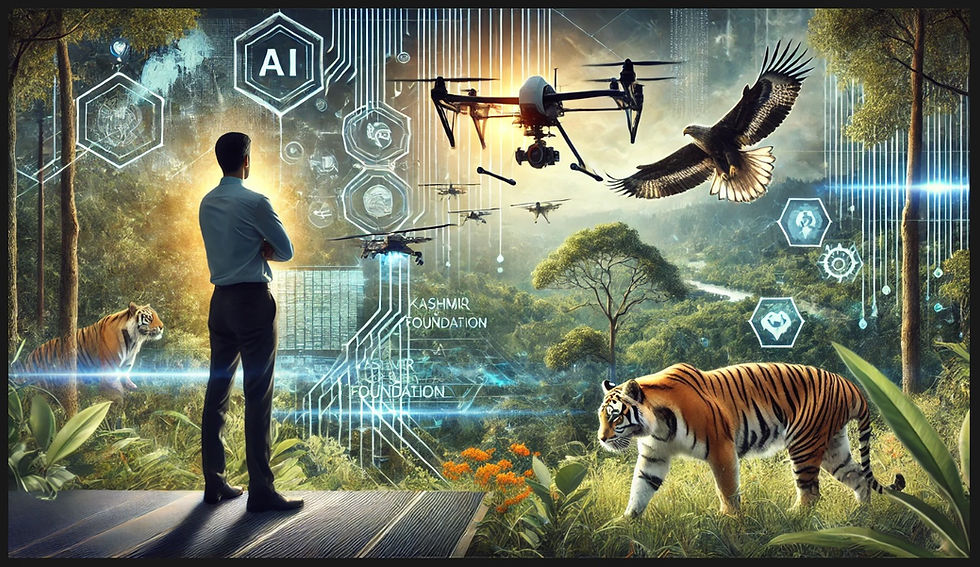African Elephant Social Structures and How It's Affected by Poaching
- Kashmir World Foundation

- Jan 24, 2015
- 6 min read
By Lisa Jorgensen KwF Wildlife Researcher
“Elephants never forget” has been a familiar idiom for generations. And there is truth to this saying, as an elephants social and ecological memories are key to its’ survival and the survival of the herd. There are 3 species of elephants. 1 Asian and 2 African: savannah and forest. Elephants have extremely complex temporal lobes, which function in processing, storing, and retrieving information gathered from all 5 senses. Relative to brain size, they have the most intricate temporal lobes of all land mammals, after humans (Miller, 2014). African elephants are known for their complex social structures, family bonds, high intelligence, adaptability, and a memory that can span many generations. A healthy elephant’s life span is approximately 70 years. Savannah herds live in the largest groups ranging from 8-100 members depending on terrain and size of family. Each elephant has its’ own personality and role in the herd. One can observe introverts, extroverts, leaders, bullies, shyness, boldness, and highly social individuals in a single herd (Elephant Voices, 2014).
The matriarch is the most influential member of the herd. She is the largest and oldest family member and her ability as a leader has a great impact on the cohesiveness of the family structure and herd survival. Her memory, for example, is relied upon during drought where she will lead the group to watering holes remembered from years, even decades, past (Defenders of Wildlife, 2014). Matriarchs earn their position through years of trust, wise decision-making, and respect from other family members. During times of crisis, the matriarch is looked upon for guidance and must display courage, resilience, and wisdom. She must also be well connected to the group both socially and genetically. Meaning, she cares for all members, not just offspring, equally (Elephant Voices, 2014).
There are several levels of relationships. A family consists of numerous related females (grandmothers, mothers, aunts, sisters, cousins) and their offspring. They welcome each other with a special Greeting Ceremony. Families display the most cohesive relationships, demonstrating evolved teamwork and cooperation in defense, offspring care, decision-making, and coordination in obtaining resources (Elephant Voices, 2014). Female family members remain together for life. Males, after reaching adolescence, leave the family to form bachelor herds, which are important in learning how to become strong, independent adult bulls. Once males enter into ‘musth,’ (15-28 years old) which is a change in behavior due to increasing reproductive hormones such as testosterone, become more solitary (Miller, 2014). The second tier is a bond group, which, like families, is dependent on genetic relatedness. Bond groups may hold 5 or more families consisting of 50 plus individuals. Even though ties across the group are weaker, close friendships are observed. Adults will aid in caring for each other’s offspring and form alliances against aggressors. Each individual also exhibits special greetings towards another (Elephant Voices, 2014). Several bond groups that reside in the same home range are called clans. Clans are used for socializing and many will gather to share resources during plentiful seasons. The more positive an experience, the larger the social gathering will be. Lastly, populations of elephants are defined as communities linked by genetics and social relationships. For example, small groups of Kilimanjaro females will travel 100km, over the course of a year, to mate with Amboseli males in near the Kenya/Tanzania border (Elephant Voices, 2014).
Traditional scientists would argue that any species other than humans do not have the capacity for empathy. Yet elephants exhibit many actions and behaviors that could prove otherwise. Providing comfort, babysitting lost calves, assistance when an individual has fallen, is immobilized, or to remove foreign objects, as well as forming alliances and providing comfort to injured elephants, and often other species are all observed as empathetic behavior (Elephant Voices, 2014).
Elephants have been observed mourning the death of their own species. They become agitated and will stroke the bones, tusks, or body of their fallen kin with their tusks and feet. Similarly, attempts to feed, cover, guard, lift, and carry a dying individual is not uncommon.
Many studies have been conducted involving the complexity of elephant social structures. Any action causing disruption would have damaging effects on solidity of said structure and the health of the species.
Poachers particularly seek after matriarchs. They have the largest tusks and are easier to locate than solitary males or small bachelor herds (Gobush, 2014). According to CITES, in 2013, over 20,000 African elephants were poached continent wide. The majority, 55%, resides in South Africa, with Eastern and Central Africa following at 28% and 16% respectively (CITES, 2014).
A 14-year study, beginning in 1997, was conducted in the northern Kenyan reserves, Samburu and Buffalo Springs, on the repercussions of poaching on elephant social structures. The study shows over ½ of the recorded mortality was due to poaching elephants over the age of 9. Sex ratios were skewed due to male deaths and stable families were completely destroyed by the loss of breeding females and, often, their offspring. These losses resulted in disrupted age structure, and a high number of orphans. Because orphans learning process are disturbed, they relate differently by forming orphan groups or remaining solitary and lack social norms that would have normally been provided by elders. Also, modern matriarchs are less experienced, younger, and are often orphans themselves or are the offspring of orphans. When looking at urine, fecal, and hormonal levels, researchers also found heightened levels of stress, as well as chemical and hormonal imbalances in disrupted groups. The complete study can be read here: http://www.plosone.org/article/info%3Adoi%2F10.1371%2Fjournal.pone.0053726
A female (cow) elephant gives birth every 6 years. Calves will nurse until a new offspring is born. Because there is no natural order in poaching, groups are highly affected by the results of lost members. Bonds between families of orphans are less resilient. Some young matriarchs, who are forced into the position, later abandon their role due to stress, pressure, and lack of experience. This causes additional stress and danger to the herd, especially youngsters, as they become confused and easy targets for predators (Sheldrick, 1992). Some groups lack a matriarch altogether. Stress is highest in groups lacking matriarchs, and/or has very few closely related members.
The absence of a solid social structure on a species who relies on it so heavily is traumatizing to the species itself and its’ ecosystem. Pachyderms (thick skin) are a keystone species in the African ecosystem. They create grasslands by knocking down large trees and bushes, their hefty footprints leave depressions in which water can collect, they dig watering holes in dried out riverbeds, and create pathways. The clearings they provide through forests and the bush are as important to humans as they are to other native species. Baboons, birds, and other species rifle through elephant dung for undigested seeds and nuts. These nutrient-rich deposits also replenished soils (SOS Elephants & Batchnet, 2010). Moreover, because of ecotourism, elephants bring in a great deal of revenue to safari parks and reservations.
One issue is the rise in human populations and competition with elephants for living space. Since the turn of the century, human populations have quadrupled in Africa’s forest and savanna regions. Land is then altered to house crops, homes, and pastures for livestock. Forests are also cut for timber. Because the land is now compromised, elephants will raid crops for food, and aggressive males in musth or during breeding season will destroy homes and farmland. Many are shot (SOS Elephants & Batchnet, 2010).
The most prominent reason for the decrease in populations is poaching. In the past 50 years, the African elephant population has decreased by 90%. It has been projected that they will become extinct by 2025 if nothing is done to curb poaching (S.A.F.E., 2012). Because areas of China are becoming more wealthy, demand for luxury items, including ivory, is heightened.

International conservation organizations are working together and with local government agencies to find a solution to end the massacre.
Kashmir World Foundation (KwF) founded a project called the wildlife conservation (unmanned aerial vehicle) challenge (wcUAVc) in hopes of drastically reducing poaching. This counter poaching challenge (CPG) inspires teams worldwide to create an aircraft that will detect, locate, characterize, and alert rangers of poaching threats within, but not limited to, Kruger National Park (KNP). And to monitor the bush around the clock where rangers cannot patrol. The KwF Animation and Design teams created this short video promoting the Kashmir Robotics counter-poaching drone. https://www.youtube.com/watch?v=Hk-oLdIPnXI&feature=youtu.be
The wcUAVc will also bring instructors and drone kits to KNP via the DaVinci Challenge, which teaches people how to build, operate, and maintain their own drones by providing a complete learning experience in designing, fabricating, and operating drones. The communities can use their drones and participate in the cause.
KwF believes by involving villages that border national parks, people living there will become part of the solution as well as create jobs, inspire, and appreciate the intrinsic value of the wildlife within. To learn more about the DaVinci Challenge and wcUAVc visit http://www.kashmirworldfoundation.org/ and http://www.wcuavc.com/
Bibliography
CITES. (2014, June). Elephant poaching and ivory smuggling figures released today. Retrieved December 2014, from Convention on International Trade in Endangered Species of Wild Fauna and Flora: http://www.cites.org/eng/elephant_poaching_and_ivory_smuggling_figures_for_2013_released
Defenders of Wildlife. (2014). Basic Facts About Elephants. Retrieved December 2014, from Defenders of Wildlife: http://www.defenders.org/elephant/basic-facts
Elephant Voices. (2014, April). Elephant Sense and Sociality. Retrieved December 2014, from Elephant Voices: http://www.elephantvoices.org/elephant-sense-a-sociality-4/elephants-are-socially-complex.html
Gobush, K. (2014). Effects of Poaching on African Elephants. Retrieved December 2014, from University of Washington: http://conservationbiology.uw.edu/research-programs/effects-of-poaching-on-african-elephants/
Miller, C. J. (2014). Animals and Conservation: Facts About African Elephants. Retrieved December 2014, from Maryland Zoo: http://www.marylandzoo.org/animals-conservation/elephant-program/facts-about-african-elephants/
S.A.F.E. (2012). Save Africa's Elephants. Retrieved December 2014, from The Bodhi Tree Foundation: http://www.thebodhitreefoundation.com/about/
Sheldrick, D. (1992). Impact in Tsavo. Retrieved December 2014, from Sheldrick Wildlife Trust: http://www.sheldrickwildlifetrust.org/html/impact.html
SOS Elephants & Batchnet. (2010). About The African Elephant. Retrieved December 2014, from SOS Elephant: http://www.soselephants.org/about_elephants.html
Sketch drawn by Chelsea Cantrell, Kashmir World Foundation. https://www.etsy.com/shop/ChelseaRaeArt




Comments